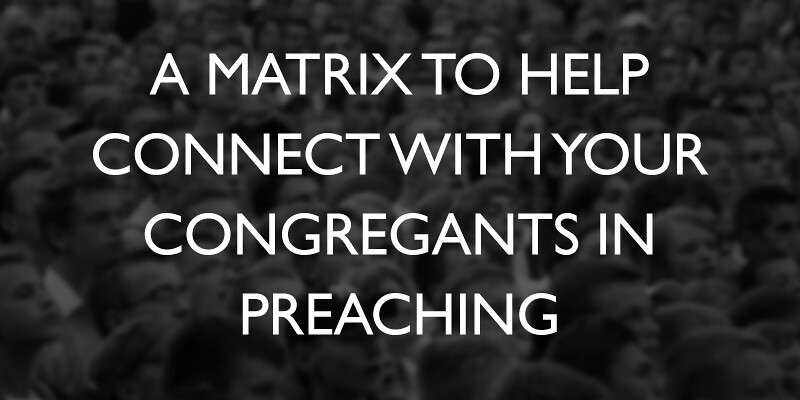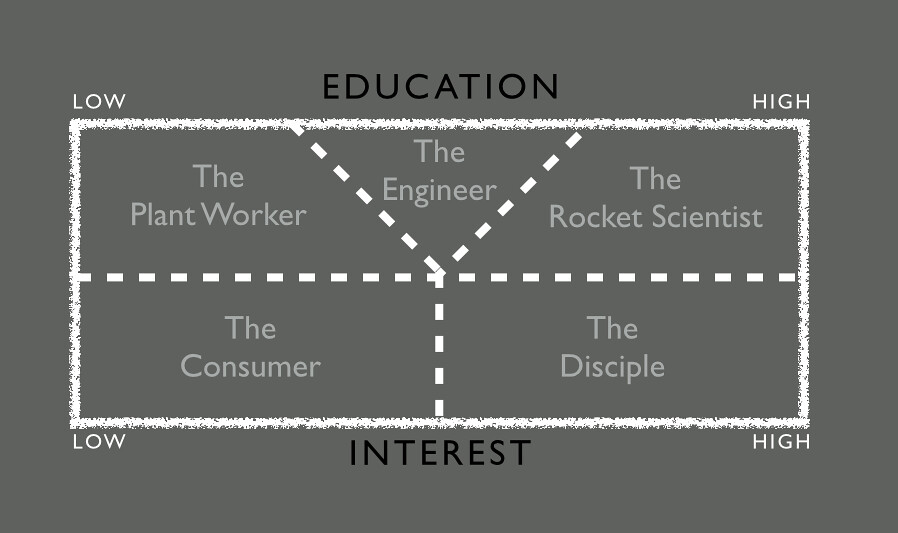 I recently led my preaching cohort through an insightful conference talk on preaching by my friend Justin Anderson. One of the things he mentioned was how he thinks about connecting with different listeners. He talked about four archetypes he preps for in preaching. Justin’s four were:
I recently led my preaching cohort through an insightful conference talk on preaching by my friend Justin Anderson. One of the things he mentioned was how he thinks about connecting with different listeners. He talked about four archetypes he preps for in preaching. Justin’s four were:
- The Mechanic – “I picture a fifty-year old dude with blisters on his hands…hard worker…’Tell me what to do.'”
- The Smart Skeptic – “You need to address their skepticism and do so intelligently.”
- The Disciple – “They bought in. They love you. They love the gospel. Give ’em some meat, something to chew on.”
- The Dude Who’s There for Chicks – “There’s a dude in your church who’s there for chicks, not for you. Talk to him.”
This can be incredibly helpful to think through when trying to communicate effectively. In some ways it’s akin in spirit to Paul’s attempt to become like those whom he sought to persuade for the gospel (cf., 1 Cor. 9:20). Justin got me to thinking about constructing our own local archetypes. I tried to put together somewhat a matrix for those archetypes. I believe it runs on two continuum.
The first continuum addresses education.
Let it be said, anytime one uses occupational archetypes for levels of education or critical thinking prowess they do so with great generalizations. For example, I know some mechanics who are incredibly erudite and some skeptics that are merely pseudo-intellectuals. We must remember these are archetypes. They are typical/popular ways society thinks about people or things. So, since I live in an area dominated by petro-chemical industry and NASA, our team constructed the ends of the continuum:
The Plant Worker <——> Rocket Scientist
Again, the sweeping generalization is of a shift worker who looks for the “how to” more than the abstract while the rocket scientist wants thought-out, articulate answers to the propositional statements they hear from the pulpit.
We also have an inordinate amount of engineers so I added them to our list. While they sit to the right of the continuum education-wise, we put them in the middle for space-sake. Why add them? Because the engineer archetype has specific distinctives about their learning process (e.g., linear thinkers) that I, as a preacher, must keep in mind if I’m to communicate well to them. This means, you may have a high concentration of a specific type of people that you cannot help but consider in the preaching event. For us, it is engineers.
The second continuum deals with interest level.
While we kept The Disciple, we replaced The Dude Who’s There for Chicks with a better archetype for our church. (I also reversed the order Justin presented.)
The Consumer <——> The Disciple
We chose consumer over the “Chicks” guy because it better describes our cultural setting. The consumer is the one who comes to our church because it’s the popular thing to do, or it’s good for business, or for any reason that isn’t spiritual in nature.
The final result was a matrix that looked like this:

What would your matrix look like? I believe this can be a helpful tool in making sure your message connects with your congregation. Sit down with your staff and construct your own.

2 thoughts on “A Matrix to Help Connect with Your Congregants in Preaching”
This ties in nicely with another article I read today ( http://www.meetthepuritans.com/blog/puritan-preaching-art-prophesying ) which takes a list of 7 archetypes, and suggests how we address them:
1. Ignorant and unteachable unbelievers we should challenge;
2. Teachable but ignorant unbelievers we can instruct;
3. Knowledgeable but impenitent unbelievers we need to stir to repentance;
4. Soundly or superficially humbled hearers to whom we can apply the balm of the gospel;
5. Believers we can teach the fullness of the gospel and the law as a guide for new obedience;
6. The backslidden in faith and life we must motivate to new faith and obedience;
7. The mixed congregation we may teach any doctrine from the law or gospel, so long as we do so from the text.
I think this maybe adds a third axis for believer/unbeliever to your original matrix?
No matter how pure of the Gospel you preach. man turns it to love himself first. As it is written: Love your neighbor as yourself.
You can only love your neighbor as yourself, as much as you feel you need too. And your nature will only Love as much as it feels safe too. But if their is a challenge socially physically or spiritually that threatens your well-being in the gospel then you will love less and less from the source of that danger as it is stated from Jesus that you cannot be my disciple or have life unless you hate your mother father sister brother lands and your wife and even your life also meaning your safety ultimately is in Jesus alone and then we reach out from there and we grow from there. . A man of God can become a hindrance if you look to him to much or to little.